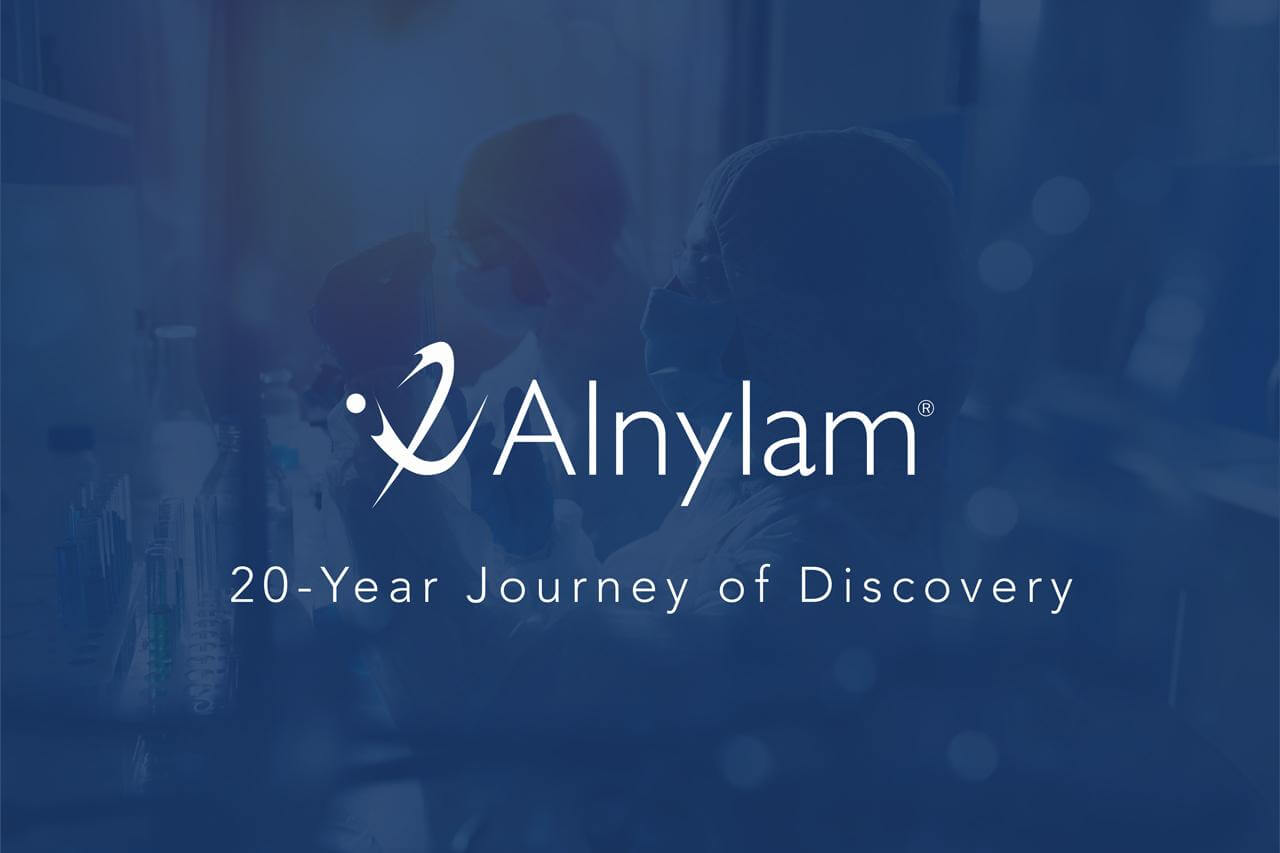Looking for something?
Alnylam’s 20-Year Journey of Discovery

Twenty years ago, a group of scientists intent on developing a new class of medicine using RNAi technology came together and formed Alnylam Pharmaceuticals, a name symbolizing their passion for discovery. The bright center star of Orion’s belt, Alnilam, has long been used as a celestial navigator, guiding explorers in their mission to discover the world. Like many explorers, the path for Alnylam was not always clear, and they appeared lost at times. Despite a constant wave of external disbelief that RNAi therapeutics was impractical and unrealistic, their internal resilience, rigorous scientific exploration, and ultimate goal of discovering a meaningful treatment for patients guided them to success.
Now, as Alnylam celebrated its 20th anniversary in 2022, they did so knowing they’ve helped pioneer the path to a class of treatments that not long ago were undiscovered.
The paper that started it all
In 1999 Nobel Laureate and Alnylam cofounder Dr. Phillip Sharp published the crucial paper that three years later would bring the five founding scientists of the company together. The article highlighted using RNA interference (RNAi) and double-stranded RNA to silence genes in mammalian cells. The discovery prompted Sharp to question if the same could be applied to human cells to treat diseases; thus, the origin of Alnylam began.
In early 2001, former Alnylam CEO John Maraganore received a call from Sharp asking if Millennium Pharmaceuticals — where Maraganore worked — was interested in learning more about his research on RNAi and mammalian cells. Soon, a group of Millennium scientists met with Sharp and his collaborators — Dave Bartel, Phil Zamore, and Tom Tuschl — where the significance of their work was immediately clear (1).
Within days of the meeting, Maraganore called Sharpe to tell him Millennium was interested in an exclusive license to the RNAi IP for research and was open to investing in a new company to explore the therapeutic potential of siRNA (1). However, at the time, Sharp and his team were hesitant about starting a therapeutics company. Instead, they countered with a nonexclusive license, making Millennium one of the first to license Tuschl I and Tuschl II patents for research use (1).
Fast-forward one year to 2002, and Alnylam Pharmaceuticals was born. Sharpe, Bartel, Zamore, and Tuschl brought on bioentrepreneur Paul Schimmel as the fifth company founder, who changed the company’s name from Precision Therapeutics to Alnylam Pharmaceuticals. Maraganore left Millennium to join Alnylam as their founding CEO in the summer of 2002.
The luster of RNAi therapeutics
Awarded “Molecule of the Year” by Science magazine and called “Biotech’s Billion Dollar Breakthrough” by Forbes, the company entered the industry during a time of RNAi fervor. The potential for the technology attracted pharmaceutical companies and investors to financially back Alnylam’s research and drew in a strong team of scientists. However, one key hurdle remained: achieving siRNA delivery to the target organs.
In 2003, the company merged with German pharmaceutical company Ribopharma AG and received $24.6 million in funding from private-equity firms. In 2007, the company secured $331 million from Swiss pharma company Roche AG.
“For a while, it seemed like nothing could stop the RNAi train,” Maraganore said. “RNAi therapeutics had enormous luster as a potential new class of medicines, and many pharma R&D chiefs just couldn’t miss out on the opportunity.”
The delivery dilemma
Despite the initial RNAi enthusiasm, pioneering the molecule into a therapeutic drug came with its challenges — specifically, how to deliver a strand of short interfering RNA to the relevant cells. Double-stranded siRNA molecules are large, making it difficult for them to pass through the cell membrane to activate the desired gene silencing (1). The molecule is also highly charged, susceptible to biodegradation, prone to stimulate immunity, and cleared rapidly by enzymes after injection (1).
During Alnylam’s infancy, more than 80% of the company’s R&D investments went toward delivery efforts. Within Alnylam’s first decade, several dozen externally sourced delivery systems for various tissues were assessed and discarded (1).
“The challenge has been — the singular challenge that stands out above all for this company — has been the delivery of our drug to a relevant target organ,” Akshay Vaishnav, head of R&D at Alnylam, explained. “We spent the longest time, ten years of the company almost before we could figure that out.”
A 2012 licensing deal to use Arbutus’s lipid nanoparticle technology — which Alnylam uses to deliver patisiran — protects the nucleic acid molecules from degradation and helps pass the molecule through the cell membrane. With this delivery method, the company could deliver patisiran to the liver, stopping the production of the TTR protein and allowing the body to clear TTR deposits in people with hereditary ATTR amyloidosis.
RNAi skepticism leads to company layoffs
However, the wave of RNAi interest began to subside at the start of the new decade as drug manufacturers became disillusioned by the ongoing problem of solving the delivery. Despite more straightforward programs targeting diseased genes in the eye or lung with ‘direct delivery’ and ‘systemic delivery’ to diseased genes in the liver showing early promise, pharma partners were skeptical of success. As pharma and investor confidence in RNAi technology dwindled, Maraganore recalled the late 2000s as a “very dark moment” for the company.
A significant investment blow came in September 2010 when Novartis, which had bought into Alnylam early on, decided not to expand its $100 million option for nonexclusive rights to Alynlam’s technology. Soon after this, Roche also dropped their investment, and it was apparent that the early 2000s RNAi boom had become a bust. In September 2010, Alnylam had to let 25% of its workforce go; at the start of 2012, another 33% followed suit (1). Maraganore said this was one of the most painful decisions as CEO and was determined to find new roles for the departing employees, reviewing a list of affected individuals and their potential new job prospects at a board meeting every week (1).
From platform to pipeline
Although investors and Pharma had seemingly abandoned the siRNA arena, Maraganore decided the best way to restore confidence in RNAi was to demonstrate indisputable human Proof of Concept (POC) results — it was time to shift from platform to pipeline (1). He decided that the best chance of success was to focus on achieving delivery to the liver. In 2011, the company created ‘Alnylam 5 x 15’, a strategy to advance five RNAi therapeutic programs focusing on the liver into clinic development by the end of 2015 (1).
A boost in confidence came in the fall of 2011, when Patient 50-03, enrolled in a study for hereditary ATTR amyloidosis, showed clear TTR knockdown in a phase 1 study using the drug patisiran, a landmark moment proving the ability to “harness RNAi in man” (1). Eleven years later, patient 50-03 continues to receive patisiran for their hereditary ATTR.
As work on Alnylam 5 x 15 continued, more promising results rolled in. By the end of 2015, eight programs were in clinic development, surpassing their initial goal of five. In Alnylam’s hemophilia treatment using fitusiran, they demonstrated increased thrombin generation and early signs of improved homeostasis (1). In the givosiran program for patients with acute hepatic porphyria, results showed reduced levels of the toxic disease metabolites (1).
With the success of Alnylam 5 x 15, it was time to set a new five-year goal: bring three or more RNAi therapeutics to market by the end of 2020 (1).
“The beauty of the five-year plans, which served to reduce strategic doubt and second-guessing, was the way our employees adopted them as a rallying cry,” Maraganore said. “It gave our team harmonization and an understanding of why these goals were important to the company and our ultimate mission of bringing medicines to patients.”
Achieving this goal wasn’t without its challenges. During phase 2 of an open-label study, reports of worsening neuropathy in patients caused a significant setback. Following a review from the Data and Safety Monitoring Board, it was recommended they stop the study due to “an imbalance of mortality against the drug arm” (1). Patients hoping the drug would offer a new treatment for their often fatal disease were devastated. Alnylam investors were unsettled and eager to leave the stock; the company lost over $7 billion in market value in just one day (1). Maraganore explained that investors feared a broader platform safety issue that expanded to all Alnylam products and the RNAi therapeutics field.
“They were seeking answers that we just couldn’t give, as we had few explanations for the mortality imbalance at the time,” he said (1).
Even after an internal investigation, the exact cause is still unknown. However, it seems the drug was poorly tolerated in an already frail population with advanced heart failure and that all the deaths occurred in the most advanced patients (1).
APOLLO trials and other positive results
Less than a year after the abandoned study, positive news came that their 225-patient APOLLO phase 3 study was “a massive success,” with treatments showing reduced neuropathy progression and improved quality of life. Audible gasps came from the attendees at an EU-ATTR meeting in November 2017 when the results were announced.
“It was a watershed moment for RNAi therapeutics and for Alnylam,” Maraganore recalled. “Most importantly, it brought new hope for patients with hATTR polyneuropathy” (1).
APOLLO’s triumph was just the start of more successes to come. 2019 saw positive results for givosiran in the ENVISION phase 3 study in patients with acute hepatic porphyria, and patients enrolled in the ORION study showed a greater than 50% lowering of LDL-C (1). 2020 brought news of positive results for lumasiran in the ILLUMINATE-A phase 3 study in patients with primary hyperoxaluria type 1. Recent developments in the HELIOS-A phase 3 study were positive for patients with haTTR polyneuropathy (1).
“We had shown our powers of innovation, resilience and strength in research, but we could now also claim to have the same powers in development,” Maraganore stated (1).
The future of Alnylam
Alnylam’s pipeline of investigational RNAi therapeutics focuses on diseases that have limited or inadequate treatments. Their platform aims to create two to four investigational drug applications every year. Appropriate to its name, which conjures images of explorers using the night sky to navigate unexplored territory, the company continues to enter unmapped areas in the landscape of diseases, navigating a path to treatment.
As 2022 celebrated 20 years in the industry for Alnylam, their day one mission of treating diseases better and transforming patients’ lives continues to be the star that guides their work.
References:
- (1) Maraganore J. Reflections on Alnylam. Nat Biotechnol. 2022 May;40(5):641-650. doi: 10.1038/s41587-022-01304-3. PMID: 35534556.
“The views, opinions, findings, and conclusions or recommendations expressed in these articles and highlights are strictly those of the author(s) and do not necessarily reflect the views of the Oligonucleotide Therapeutics Society (OTS). OTS takes no responsibility for any errors or omissions in, or for the correctness of, the information contained in these articles. The content of these articles is for the sole purpose of being informative. The content is not and should not be used or relied upon as medical, legal, financial, or other advice. Nothing contained on OTS websites or published articles/highlights is intended by OTS or its employees, affiliates, or information providers to be instructional for medical diagnosis or treatment. It should not be used in place of a visit, call, consultation, or the advice of your physician or other qualified health care provider. Always seek the advice of your physician or qualified health care provider promptly if you have any healthcare-related questions. You should never disregard medical advice or delay in seeking it because of something you have read on OTS or an affiliated site.”








